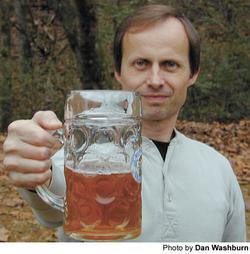January 31, 2002
Home Brewing: The science of making suds
That was the question posed by Dennis Brown's baseball cap. I'm assuming it was meant to be rhetorical. I was spending the day with the Chicken City Ale Raisers -- Gainesville's home brewing club -- and they always "got beer."
If they run out, they just make some more. But I think running out is against club rules.
We were in the Murrayville basement of Rick Foote, a longtime zymurgist (that's baroque for brewer) and the club's president. That's a title he'll hold for life, he often says, because nobody else wants it.
"Being here in the Bible Belt, it seems we must always fight the stereotype that we're low-life drunks," said Foote, 42, who moved to Gainesville from Pennsylvania, by way of Vermont, 10 years ago. "You mention beer or home brewing and people snicker. What's the big deal? We're all grown ups. I mean, beer is ... beer."
Well, perhaps not all beer is beer according to Chicken City Ale Raiser standards. There was quite a bit of Bud-bashing going on in the basement. Someone down there even referred to our nation's self-proclaimed "King of Beers," and its many imitations, as "American swill."
And -- at the risk of insulting 97 percent of Americans -- I tend to agree. I prefer beer you can't see through. The Ale Raisers were happy to hear this, and very eager to introduce me to their creations.
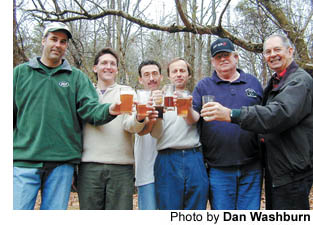 "Someone who drinks Budweiser -- Joe Six Pack -- isn't going to appreciate this type of beer," Lance Huthwaite, 32, a dentist from Clermont, said as he handed me a Classic American Pilsner that the club brewed "pre-Prohibition style."
"Someone who drinks Budweiser -- Joe Six Pack -- isn't going to appreciate this type of beer," Lance Huthwaite, 32, a dentist from Clermont, said as he handed me a Classic American Pilsner that the club brewed "pre-Prohibition style."
I looked at my watch. It was just after 10 a.m.
"I guess it's never too early for a beer," I said.
"Not if you're brewing," Richard Louise, a Gainesville stockbroker, said. "The rule is: if you brew beer, you can drink beer."
And we were brewing beer -- from scratch. That's what Foote's basement was built for, it seems. It's the laboratory of a mad zymurgist. Kegs and coolers, tubes and trinkets everywhere. Foote calls it the Whistle Pig Brewery.
It features two refrigerators. One for hops and yeast. The other for beer, lots of it. It flows freely from taps rigged to the fridge. (For those under 21, like Foote's children, the tap to the far right serves homemade root beer).
Foote, recycling guru for Hall County, had the plumbing lines in his house re-routed for purposes of beer brewing. Turn a series of knobs on an intricate maze of pipes, and water flows pure from Foote's well to an outdoor wood-burning heater. Then it travels into the basement through a spigot conveniently placed above Foote's brewing contraption.
One catch: when filling the brewing kegs, the water to the rest of the Foote house runs dry.
"Are you turning off my water now?" Foote's wife Carolyn called down from upstairs.
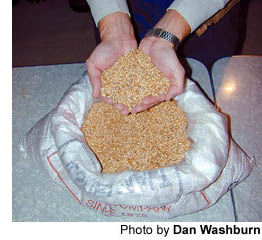 "Yes," Foote replied. "Dishes and whatever else are going to have to wait for beer."
"Yes," Foote replied. "Dishes and whatever else are going to have to wait for beer."
But this is nothing new for the Foote household. They were, after all, married on the first Saturday in May -- National Homebrew Day -- several years ago. (Foote claims that happened by accident.)
"Our second date was, 'Come over to my apartment and see how we brew beer,'" Carolyn said. "But it's fun. And it keeps him at home."
Brewing kept Foote home Jan. 12. It kept five other Ale Raisers, and one newspaper reporter, at his home, as well. We brewed an ale -- from barley to boil and points beyond -- and the process lasted more than eight hours.
No one step is more important than the others, I was told. They all need to be done if anything's going to be drinkable. But one thing is paramount for potability: cleanliness.
Thankfully, and with all due respect to the late Phil Hartman, Foote is fine fill-in for The Anal-Retentive Brewer.
"If you're brewing at your house and Rick's there," said Brown, 52, of Cumming, whose "GOT BEER??" hat lights up, by the way, "you set a piece of equipment down and it's cleaned and sterilized before you can pick it back up."
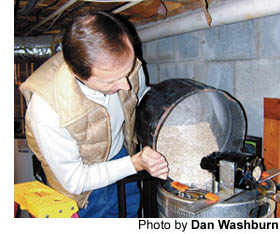 That's a good thing. It's as much about the science as it is about the suds. We followed a strict recipe -- with line graphs and everything -- down to the degree, down to the second.
That's a good thing. It's as much about the science as it is about the suds. We followed a strict recipe -- with line graphs and everything -- down to the degree, down to the second.
"You can get as deep into it as you want. It involves a lot of different disciplines: engineering, physics, chemistry, biology," said Foote, who in 1996 attended a weeklong course on microbrewery and pub brewery operations at the Siebel Institute of Technology in Chicago.
Now, science has never been my forte. Never will be. So, I could throw out a lot of mumbo-jumbo here about mashing, sparging, enzymes, wort and the like. But you'd know I was faking it. You'd know I was just in it for the beer.
And it's good beer, too. On Monday, I tried some of the batch I helped brew -- OK, I mostly just watched -- and I was rather impressed. Last year, the Ale Raisers won eight ribbons at the Peach State Brew Off.
"The best part is drinking it," said Brown, a carpenter at Gainesville College. "Even if it doesn't come out perfectly, it's still a decent beer."
Added Foote, "The kick I get is that people go out and buy beer like this. And I can make it in my home."
You don't need a set-up like Foote's to brew, either. Beginners can get started for less than $100. Club member Phil Farrell, an airline pilot from Cumming, brews on top of his wife's stove. The most he can make at once is five gallons, which is about one-third of what we brewed at Foote's place.
"I really can't do much bigger than that," Farrell said. "The burners wouldn't be able to handle it. Plus, my wife would kick me out of the house."
Man has brewed beer, in some form or another, for around 5,000 years now, but not until 1993 could you legally do it in your home in Georgia. Interestingly, it was Georgian Jimmy Carter who passed the federal legislation that legalized home brewing in 1978.
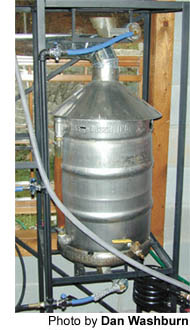 The beer we made was a clone of Sierra Nevada's Celebration Ale, which the San Francisco Chronicle once dubbed the "best beer ever made in America." Sierra Nevada actually lists all of the specs and ingredients for its beers on the Internet.
The beer we made was a clone of Sierra Nevada's Celebration Ale, which the San Francisco Chronicle once dubbed the "best beer ever made in America." Sierra Nevada actually lists all of the specs and ingredients for its beers on the Internet.
"I'm sure they're flattered that home brewers would want to emulate one of their favorite beers," Foote said. "I mean, who'd want to clone a Budweiser?"
By that time, most of our day of brewing was finished. All we had left to do was add the yeast and let our concoction ferment for two weeks.
It was after 5 p.m. I knew because I looked at Foote's ... hey, wait a minute. Is that a Budweiser clock?
Foote looked a little ashamed. Then he said, "It was free."
For more information on the Chicken City Ale Raisers, email them.
January 24, 2002
Being a Fan: Hoops rivalry turns friends into foes
 Clinton Howard stood up and screamed: "Ohhhhh! Ohhhhh! Ohhhhh!"
Clinton Howard stood up and screamed: "Ohhhhh! Ohhhhh! Ohhhhh!"
He pointed his finger outward repeatedly at nothing in particular. In several settings, such behavior would merit a trip to the mental ward. But not at a boys high school basketball game between East Hall and Gainesville.
No, at such a slugfest you're considered crazy if you don't act a little crazy.
"I holler a lot, but I know when to stop hollerin'," admitted the 58-year-old Howard, a 1961 East Hall graduate, who can count on one hand the number of East Hall-Gainesville games he has missed since the rivalry -- one of Georgia's most heated -- got its start back in 1958.
Last Saturday night in East Hall's gymnasium, Howard had plenty to holler about. The Vikings defeated Gainesville, 111-92, to post a 2-1 record against the Red Elephants this season. East Hall has now won 11 of the last 13 games in a series that historically could not be any closer.
The teams have played 110 times. The tally? Vikings 55. Red Elephants 55. Wow.
"It's electric when these two teams play," said longtime Gainesville supporter Bobby Wiley, 69. "It's just super-charged. More so than any other rivalry I know of."
Some say the wattage was weakened last weekend. Gainesville, a final four team a year ago, is struggling to stay above .500. East Hall has no starters back from last year's team that won the Class AA state championship.
And quietly, several suggest that recent scrutiny of fan behavior locally has sapped some spirit from the stands. Hall County and Gainesville school administrators, prompted by what they called "disturbing incidents" of fan misbehavior, approved a resolution in December to weed out the jeers from the cheers at high school sporting events.
Gainesville's famed student section -- known as "Amen Corner" -- was a no-show Saturday. Neither Howard nor Wiley had ever seen that happen before.
"This game, usually every seat is full, and they're lined up three or four deep up there," Wiley said pointing to the standing-room-only section above the bleachers. "So (the resolution has) taken two or three hundred people away from the game."
Still, a couple thousand fans braved the rain and showed up Saturday. The stands appeared full by the start of the boys game. And the standing-room-only section had its share of occupants. It just wasn't packed as sardine-tight as usual.
Howard and Wiley were on hand, to be sure. I sat with Howard during the first half, and joined Wiley for the second. I brought good luck to Howard and bad to Wiley.
There are no assigned seats in East Hall's gym, but everyone knows which seat belongs to Howard. Front row and center, directly across from the scorer's table. And it doesn't matter to Howard that his seat of choice happens to sit in the middle of enemy territory.
"I can see the floor good," said Howard, who works in the vending industry. "And I get to holler at the officials. That's part of the game."
Howard knows all of the officials by name, and most of them have gotten to know his name over the years, as well. They certainly recognize his voice:
"He walked. He did."
"C'mon, he's fouling him."
"You missed that one."
Even when Howard and the officials agree that there was a foul, he'll often complain that the wrong type of foul was called.
"He got him with the body," Howard yelled after an official said a foul was on the arm. "Bull."
Howard likes to be close to the action. During football season, he carries the first-down chains on the sidelines for East Hall.
"So, do you sit in the dugout for baseball?" I asked.
"No, they have another guy that does that," Howard said. "But they know I'm there."
There have been a few occasions over the years where Howard arrives at the gym to find his block of bleacher already occupied. It never stays that way for long. And he rarely runs into the problem anyway. You see, Howard likes to arrive early.
The boys game started at 8:30 p.m. on Saturday. Howard was at the gym at 4 p.m. to watch the early games.
"You gotta watch the little ones coming up, see what they're gonna be," Howard explained.
Howard's wife Gracelyn, former assistant principal at East Hall, sits behind her husband at the games. She prefers not to sit beside him -- Howard's "sidekick" Jason Gibson does that.
Gibson, 23, is a North Hall graduate but says he's "a Viking for life."
Is he the front-row fan of the future?
"I plan to be, but he'll probably be around 'til he's 110," Gibson said with a chuckle.
Howard was forced to miss an East Hall game recently. There was a dinner engagement he couldn't get out of.
"I told coach (Seth Vining) I wouldn't be there," said Howard, who often talks to the team in the locker room after the game. "He'd wonder where I was at."
Howard never stopped talking and never sat still for long during the first half Saturday. East Hall jumped out to a 50-39 halftime lead that had Howard jumping out of his seat quite often.
"You're going to have more fun sitting down here with us than you are with that other guy," Howard said with a big smile.
Wiley -- that other guy -- and Howard actually know each other well. Away from the game, actually they are good friends.
"To me it's just a good, hard, clean rivalry," Wiley said. "I pull for East Hall when they ain't playing Gainesville."
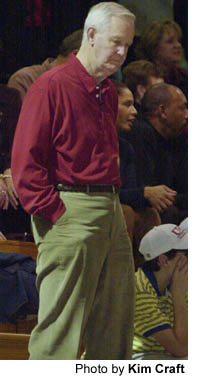 Wiley is 6-foot-6. He towers over Howard and most everybody else. For most of the second half, he sat with his long legs tucked tight to his body, his long arms wrapped around them.
Wiley is 6-foot-6. He towers over Howard and most everybody else. For most of the second half, he sat with his long legs tucked tight to his body, his long arms wrapped around them.
Wiley attended Riverbend High, which existed before the small county schools consolidated into North, East and South Hall. Had he been born 10 years later, Wiley could have ended up a Viking.
The horror.
But all three of his children were Red Elephants, and since the early 1970s, Wiley has been one, too. I had been told that Wiley had a reputation for being rather vocal at games. On Saturday, there wasn't much for him to be vocal about.
So we talked basketball. Gainesville-East Hall, in particular.
"It's all these banners," Wiley said pointing to the rafters lined with championships. "Gainesville has the same thing. They are the two best programs in Northeast Georgia, at least."
And we watched as the players raced back and forth, on their way to combining for more than 200 points.
"One of my classmates who I played with got the idea that we could have played with these kids," said Wiley, who owns a paint store in town. "I said, 'Forget it.' They jump higher. They're more athletic.
"When I played, you couldn't dunk it. It was a technical if you dunked the ball. There wasn't anybody who could dunk it anyhow."
With 5:38 to play, East Hall increased its lead to 86-66.
"It's all over but the shouting now," said Wiley, at the game with a son and three grandsons. "I think we're going to slide out and beat the crowd."
So I went back down and sat next to Howard again. He never leaves.
"That's not a true fan," Howard said of Wiley's early exit.
"I'll let you tell him that," I replied.
"Oh, I will."
January 17, 2002
Skiing: A lesson in 'mind over mountain'
The "snow" at Sky Valley Ski Resort near Dillard looks as though it seeped up through a crack in the Earth. There's a bright strip of white from mountain-top to mountain-bottom, and it's surrounded on both sides by still-green trees and grass.
The scene looks unnatural, and it is. All three feet of packed powder on Sky Valley's slopes are manmade.
But you can still snap sticks onto your shoes and slide down this spurious stuff of white. And in Georgia, that's about all you can ask for.
Sky Valley -- not surprisingly Georgia's only ski resort -- is just an hour's drive from Gainesville. It's a few thousand feet above sea level and a few thousand feet from being in North Carolina.
But last Friday -- mid-January -- temperatures at Sky Valley approached 50 degrees and made the notion of participating in a winter sport seem rather absurd. Snow is not so dry and fluffy when it's melting.
"When you go down in it in these temperatures," said my skiing instructor Daniel Williams, 27, of Franklin, N.C., "you're going to get wet. And once you go down, it's a miserable day."
Unless, of course, you are dressed for the occasion. I had a feeling I'd be falling, so I chose clothes that would try to keep me dry.
Even though I grew up just outside of Pennsylvania's Pocono Mountains, even though I went to a high school that had a ski club, I had only been downhill skiing once before my lesson last week in the North Georgia mountains.
My initial experience some six years ago was both exhilarating and excruciating. It made me understand why my high school basketball coach prohibited his players from participating in alpine activities during the season.
Most skiing in the South takes place on water, so beginners are expected at Sky Valley. The first thing Williams taught me to do was fall, something I would later become quite skilled at.
Next, he taught me how to avoid a fall -- something I still need to work on.
"The key to skiing is controlling your speed," Williams explained. "If you know how fast you can go, if you can control that, it doesn't matter how steep the slope is."
To put on the brakes, skiers either turn from side to side or employ a technique known as the snow plow, basically traveling pigeon-toed down the slope.
Don't know how to do either one? Prepare to be a projectile.
Midway through my tutorial on the appropriately-named Pokey slope, a voice through Williams' radio said a girl was being taken to the first-aid room.
"Uh oh," Williams said. "Probably didn't take a lesson."
Williams said he thinks he's got the "best job in the world." Too bad in Georgia he's only able to do it a couple months out of the year. Sky Valley is currently open Fridays, Saturdays and Sundays, but everything is generally labeled with a qualifier: "weather permitting."
But, hey, this is the Deep South. What did you expect?
"It impresses some people just to be able to drive to it," Williams said of Sky Valley, which during most of the year is a golf resort (in fact, there were some folks golfing the same day that I skied). "Now, it's not elaborate by any means. You don't have slopes all the way around the mountain like, say, Utah. But it's still a fun day."
For a beginner, Friday morning is the best time to visit Sky Valley. The crowds don't come until later in the weekend. And fewer people is a luxury when you're learning.
There will be plenty of times when you're thankful there's no one around to laugh at you.
Like when you lose a ski getting on the lift, and someone is forced to tote it to the top of the mountain for you.
Like when you stumble onto your side getting off the lift, and must duck your head to avoid the further humiliation of being hit by the chair that brought you there.
Like when you fall violently on the Scooter slope, and leave a trail of tragedy to dot your hapless path: one pole, then the other, your right ski, then your left, and finally you (hopefully that part lands in one piece).
A first-aid guy skied past me as I brushed myself off from one such wipeout. I'd like to believe that he was simply making his normal rounds.
I skied the fine line between control and chaos for much of the day, constantly swerving from one state of being to the other, and finding odd pleasure in both.
The key is finding a balance. It's mind over mountain.
"I like that it's perpetual motion," Williams said. "It's all downhill. It's just free and easy. I love it."
I got to where I could stand all the way through the Scooter slope, and I decided to move on to the more advanced Panorama path because I heard a 7-year-old girl say to her younger sister that it was "easy."
I never made it down the Panorama without falling at least once.
Williams instructed me earlier to break out the ol' snow plow technique whenever I found myself saying, "Oh my God, oh my God," while speeding down the slope. He didn't tell me what to do when the snow plow didn't manage to scoop up all the "Oh my God"s.
Snow Skiing at Sky Valley
- Facts: Sky Valley Resort, Sky Valley, Ga. 3,500-feet elevation. Five trails, beginner to advanced (three are currently open). Longest run, .5-miles. Vertical drop, 250 feet. Season runs through mid-March, weather-permitting.
- Hours: Ski slopes are open Friday, Saturday and Sunday, 9 a.m.-10 p.m., and this Monday (MLK day), 9 a.m.-4 p.m. All hours subject to weather conditions.
- Rates: Depending on day and hour, adult equipment fees range from $13-$22, lift tickets $15-$32, tow tickets $10. Youth (10 and under) and senior citizen (60 and over) equipment fees range from $11-$18, lift tickets $12-$25, tow tickets $10. For snow boards, add $7 to equipment cost. All rates subject to change.
- Lessons: Private and group lessons are available 9:30 a.m.-2:30 p.m. Friday-Sunday. There is a group lesson nightly at 6 p.m. Fees: private, $30/hour per person; semi-private, $30/hour first person, $15/hour each additional person; group, $15/hour per person. Minimum age is 8.
- Directions: Follow I-985 north to U.S. 441/23 north through Clayton and into Dillard. Turn right at only red light onto Highlands Road (Ga. 246). Sky Valley Resort is 4 miles on the right.
- Information: Call (800) 437-2416 or visit www.skyvalley.com
January 10, 2002
Winter Hiking: The refreshment of refrigeration
I went home for the holidays again this year. Bloomsburg, Pa., hadn't changed much. It never does.
The town was just a year older. And, as I was often reminded during my stay, so was I.
Annual tackle football games with old friends take longer and longer to recover from. So do late-night outings at old haunts with my dear friend Yuengling Lager.
But a walk in the woods during winter has a way of enlivening the soul.
The thermometer on my mom's back porch read 18 degrees on the morning of Dec. 27, and the Weather Channel was reporting that 6 feet of snow fell on someplace called Cheektowaga, N.Y.
The ground in Bloomsburg, however, was bare. Sometimes if you want a white Christmas, you have to search it out. I found mine in the Appalachian Mountains of Central Pennsylvania.
Granted, I did this two days after Christmas Day. And snow-wise, all I found in Bald Eagle State Forest was a light dusting -- nothing like the 6 inches that awaited me upon my return to the Deep South. But, at the time, I was willing to take what I could get.
So was my high school friend Justin Gage, now a resident of Bozeman, Mont., who has become acclimatized to deep snow and tall mountains. Although the "mountains" of middle Pennsylvania don't compare much to the Rockies.
I had a little trouble figuring out what to wear for our hike. I have lived in the South for more than three years now. Here, temperature readings of 18 are unheard of, unless you happen to be talking in degrees Celsius, and I've never heard a Southerner do that.
So I just piled on layer after layer. After five miles of hiking -- some on steep slopes of slippery rock -- I started peeling them off. Despite the weather, I remained rather warm.
As we drove west away from Bloomsburg, everything got whiter -- even the usually black roof of an Amish horse-and-buggy that we passed along the way.
The roads we traveled to our destination -- The Hook Natural Area, a 5,119-acre tract in Bald Eagle State Forest -- set the old-timey tone for our trip. They were roads of gravel and dirt with names like Stony Run, Buffalo Flat and Old Shingle.
Bald Eagle State Forest -- named after an American Indian chief, not the bird -- encompasses nearly 200,000 acres and has more than 200 miles of hiking trails. The land, the last refuge of the mountain buffalo in Pennsylvania, was settled in the late 1700s when Revolutionary War soldiers received their land grants.
Logging companies purchased the acreage in the late 1800s and, after ridding the forest of many of its trees, sold it to the state.
The Hook Natural Area now houses plenty of trees, and a preserved watershed. When we got there, the North Branch of Buffalo Creek was babbling despite the freezing temperatures.
Molasses Gap Trail is steep and rocky as it heads toward Buffalo Creek from Old Shingle Road. Blue blazes mark the path, but Justin and I still managed to wander off course a time or two.
We couldn't blame poor visibility for our wrong turns, either. Leaves had left the trees long ago. There were, though, some signs of the unseasonably warm winter the North had been experiencing for much of December.
In odd contrast to all the brown and white, rhododendron and fern leaves were bright green, but recently wilted. Winter's surprise attack seemed to have caught them off guard.
No leaves. No color. No people, either. Winter hiking allows for stark solitude. Everything is crisp and clear ... and cold.
But for hikers, the cold can actually be comfortable. The refrigeration can be rather refreshing. Winter hiking can be invigorating.
"Unless you stop," Justin warned. So we didn't do that often.
We trudged on along our route of rocks: Molasses Gap Trail to Jones Mountain Road to Mule Shanty Trail.
Buffalo Creek was frozen in spots. Snow fell off and on. And temperatures never left the teens.
Oddly, I never felt more alive.
Winter Hiking Tips
- Clothing: Wear layers of synthetic fabrics. Do not wear cotton. First layer, longjohns that wick moisture from your body. Second layer, wool or fleece for insulating. Third layer, a wind- and water-repellent outer shell. Top off with hat and gloves.
- Food and drink: Drink plenty of water and eat plenty of carbohydrates -- even if you don't think you are thirsty or hungry. Human appetites diminish in the cold, despite the fact that winter activities require the body to burn more fuel. Keep water bottles from freezing by storing them in a wool sock or insulated cover.
- Use caution: Be overly careful around bodies of water. Water conducts heat away from the body 25 times faster than air. It's a good idea to carry at least an extra pair of socks.
- Plan ahead: In winter, everything takes longer. Be conservative when planning hikes. And check the weather forecast before you go.
